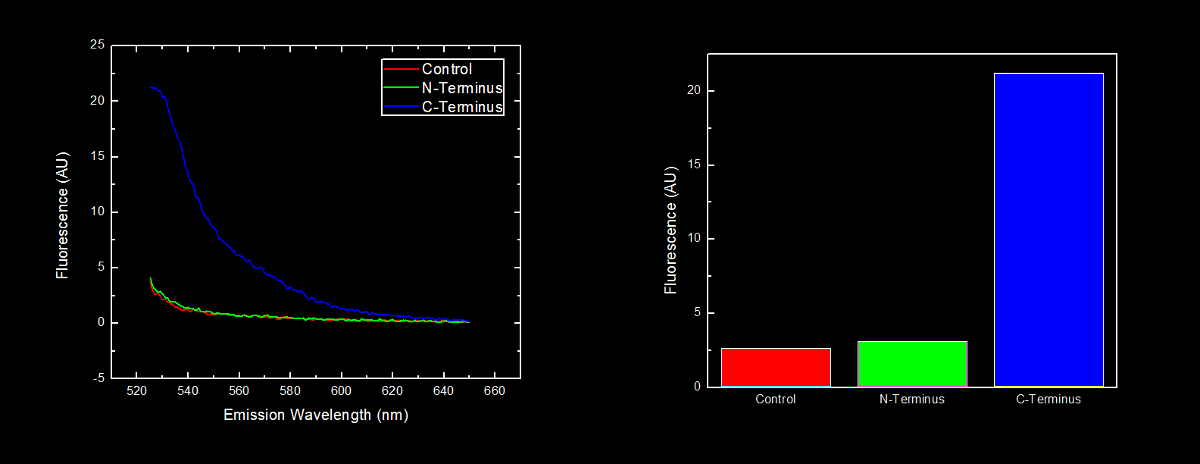Team:Lethbridge/Results
From 2010.igem.org
Liszabruder (Talk | contribs) (→Characterized Parts) |
Liszabruder (Talk | contribs) |
||
| Line 188: | Line 188: | ||
===<font color="white">Hypothesis</font>=== | ===<font color="white">Hypothesis</font>=== | ||
<hr> | <hr> | ||
| - | Light will be observed at | + | Light will be observed at 476 nm when cells containing <html><a href="http://partsregistry.org/wiki/index.php/Part:BBa_K331033" target="new"><font color="#00DC00">BBa_K331033</font></a></html> are illuminated with light at 439 nm as a result of the excitation and subsequent fluorescence of Cyan Fluorescent Protein (CFP). |
<br><br> | <br><br> | ||
===<font color="white">Introduction</font>=== | ===<font color="white">Introduction</font>=== | ||
<hr> | <hr> | ||
| - | Prior to introducing a oligoarginine tail onto the catechol 2,3 dioxygenase protein with the intention of directing the fusion protein into a lumazine synthase microcompartment, there must be some confirmation that oligoarginine tail is indeed causing the protein to which it is attached to localize within the microcompartment. We chose to utilize a technique known as fluorescent resonance energy | + | Prior to introducing a oligoarginine tail onto the catechol-2,3-dioxygenase protein with the intention of directing the fusion protein into a lumazine synthase microcompartment, there must be some confirmation that oligoarginine tail is indeed causing the protein to which it is attached to localize within the microcompartment. We chose to utilize a technique known as fluorescent resonance energy transfer<sup>1</sup> (FRET) to verify localization. In FRET, when a dye pair comes into close proximity to one another, one dye (the donor) will transfer some of its energy to the second dye (the acceptor). This will cause the acceptor to fluoresce without direct excitation. The dye pair we have chose is CFP as the donor and yellow fluorescent protein (YFP) as the acceptor. |
<br><br> | <br><br> | ||
Here we investigate the ability of <html><a href="http://partsregistry.org/wiki/index.php/Part:BBa_K331033" target="new"><font color="#00DC00">BBa_K331033</font></a></html> to produce CFP and emit light at its characteristic emission wavelength. | Here we investigate the ability of <html><a href="http://partsregistry.org/wiki/index.php/Part:BBa_K331033" target="new"><font color="#00DC00">BBa_K331033</font></a></html> to produce CFP and emit light at its characteristic emission wavelength. | ||
| Line 202: | Line 202: | ||
In order to characterize the tetracycline repressible CFP (BioBrick <html><a href="http://partsregistry.org/wiki/index.php/Part:BBa_K331033" target="new"><font color="#00DC00">BBa_K331033</font></a></html>), cyan fluorescent protein (CFP-<html><a href="http://partsregistry.org/wiki/index.php/Part:BBa_E0020"target="new"><font color="#00DC00"">BBa_E0020</font></a></html>) with an oligoarginine tag fused to the C-terminus (<html><a href="http://partsregistry.org/wiki/index.php/Part:BBa_K331025"target="new"><font color="#00DC00">BBa_K331025</font></a></html>) (and preceded by a ribosomal binding site – <html><a href="http://partsregistry.org/wiki/index.php/Part:BBa_B0034"target="new"><font color="#00DC00">BBa_B0034</font></a></html>) was synthesized. We used our Red/White 3-Antibiotic assembly method to add a tetracycline repressible promoter (<html><a href="http://partsregistry.org/wiki/index.php/Part:BBa_”R0040"target="new"><font color="#00DC00">BBa_R0040</font></a></html>) for constitutive expression of the fusion protein. This construction yielded BioBrick <html><a href="http://partsregistry.org/wiki/index.php/Part:BBa_K331033" target="new"><font color="#00DC00">BBa_K331033</font></a></html>. | In order to characterize the tetracycline repressible CFP (BioBrick <html><a href="http://partsregistry.org/wiki/index.php/Part:BBa_K331033" target="new"><font color="#00DC00">BBa_K331033</font></a></html>), cyan fluorescent protein (CFP-<html><a href="http://partsregistry.org/wiki/index.php/Part:BBa_E0020"target="new"><font color="#00DC00"">BBa_E0020</font></a></html>) with an oligoarginine tag fused to the C-terminus (<html><a href="http://partsregistry.org/wiki/index.php/Part:BBa_K331025"target="new"><font color="#00DC00">BBa_K331025</font></a></html>) (and preceded by a ribosomal binding site – <html><a href="http://partsregistry.org/wiki/index.php/Part:BBa_B0034"target="new"><font color="#00DC00">BBa_B0034</font></a></html>) was synthesized. We used our Red/White 3-Antibiotic assembly method to add a tetracycline repressible promoter (<html><a href="http://partsregistry.org/wiki/index.php/Part:BBa_”R0040"target="new"><font color="#00DC00">BBa_R0040</font></a></html>) for constitutive expression of the fusion protein. This construction yielded BioBrick <html><a href="http://partsregistry.org/wiki/index.php/Part:BBa_K331033" target="new"><font color="#00DC00">BBa_K331033</font></a></html>. | ||
<br><br> | <br><br> | ||
| - | The BioBrick containing plasmid was transformed into Escherichia coli DH5α cells. These cells were grown to an | + | The BioBrick containing plasmid was transformed into Escherichia coli DH5α cells. These cells were grown to an OD<sub>600</sub> of approximately 0.7 in LB media, and diluted 1:10 with MilliQ H<sub>2</sub>O immediately prior to analysis by fluorescent spectroscopy. |
<br><br> | <br><br> | ||
| - | This dilution of cells was excited at 439 nm, and the emission spectra was read from | + | This dilution of cells was excited at 439 nm, and the emission spectra was read from 444 nm to 650 nm. |
<br><br> | <br><br> | ||
===<font color="white">Results</font>=== | ===<font color="white">Results</font>=== | ||
<hr> | <hr> | ||
| - | Fluorescence at | + | Fluorescence at 476 nm was observed. This peak, along with a shoulder occurring at approximately 510 nm is consistent with results obtained by McRae<sup>1</sup> <i>et al.</i> in their rapid purification of ECFP. |
[[image:UofL.cfpfigureblackjpg|900px]] | [[image:UofL.cfpfigureblackjpg|900px]] | ||
<br><br> | <br><br> | ||
 "
"













